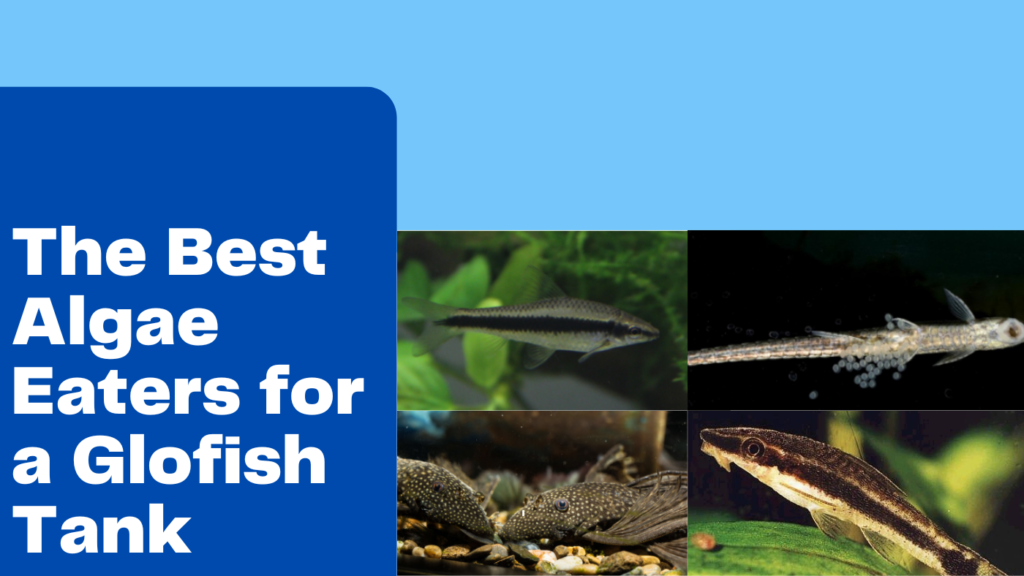If you are interested in clearing up some of the algae in your glofish tank, algae eaters are a great option. Aside from controlling the algae in your tank, they can also eat uneaten food that floats to the bottom of the tank before it decomposes. This can help prevent ammonia and other harmful chemicals in your tank.
While there are plenty of different kinds of algae eaters after, not all of them are compatible with a glofish tank. Therefore, it is important to now what algae eaters can live with glofish.
Best algae eaters for a glofish tank
The best algae eaters for a glofish tank are Siamese Algae eaters, Bristlenose Plecosneed, Twig cat fish, and Otocinclus.
Most pet stores should carry at least one of these species.
When it comes to choosing the best algae eater for a glofish tank, it’s important that they share similar water parameters and demeaner.
It terms of temperature, most glofish species require a water temperature of approximately 72-82 degrees fahrenheight, and a ph level of around 6-8, but it can vary by species. Most glofish are also non-aggressive.
When choosing an algae eater, its important that you get one that can live in the conditions listed above. Now I will go into more detail with my top choices.
Siamese algae eater

Siamese algae eaters are a great choice for a glofish tank. They have similar water requirements, needing a temperature between 75 and 79 degrees, and can withstand pH levels between 6.5 and 8. While they prefer hair algae, they will feed on most species of algae.
They can be kept by themselves or in schools. While they can reach a length of up to 6 inches, they typically don’t grow longer than 4 inches. The only downside with these algae eaters is that they require larger tanks. Ideally, they should be kept in tanks that are at least 25 gallons.
Bristlenose Plecos need

Bristlenose Plecos needs are another algae eater that are very compatible with glofish. Typically, they will eat green or brown algae.
They can withstand a temperature range of 73 to 80 degrees fahrenheight, and a ph level between 6.5 and 7.5.
These are a very peaceful species of fish, so you don’t have to worry about them being aggressive with your glofish. They can be kept by themselves or in groups.
They usually reach a size of around 4 to 5 inches and should be kept in a tank that is at least 15-20 gallons.
Twig cat fish

As the name suggests, Twig catfish are long and skinny and resemble a twig. They are a great algae eater species for your glofish, especially if you have a smaller tank. They usually only reach a length of around 3 to 4 inches, and they can be kept in tanks as small as 10 gallons. These fish do prepare to live in groups of at least 2.
They are a very hard species, and can withstand pH levels between 6 and 8. Their preferred temperature range is between 75 and 80 degrees fahrenheight, which is the same for most glofish species.
Otocinclus

Last on the list is the popular Otocinclus. These algae eaters are peaceful yet social fish, so they are a good choice if you have active glofish that like to swim around a lot. Otocinclus like to be kept in groups of at least 5. Luckily, they only grow to a length of 2 inches, so they can be kept in tanks as small as 15 gallons.
Otocinclus typically eat green and brown algae, especially when they grow on the tank’s glass.
Things to keep in mind when getting algae eaters for your glofish tank
It is important to keep in mind that algae eaters should not be your only solution to keeping your glofish tank clean. While they will help control algae levels and eat uneaten food, it is still important that you have a strong filter for your tank.
Additionally, you should perform water changes at least every other weak to help remove toxins from the water and to replenish the water with oxygen.
You can learn some more helpful tips on my guide on how to clean a glofish tank.
Another often overlooked aspect of algae eaters is that most of them still need to be fed commercial food aside from the algae they are eating. Do research on whatever species you get in order to determine what type of commercial food they need.
Since glofish are top feeders and algae eaters are bottom feeders, you might have to get two separate foods. A common food for algae eaters is algae wafers.
You should also make sure to provide a lot of hiding spots and decorations in your tank. This will give both your glofish and algae eaters places to hide and rest.
Lastly, you should add algae eaters to your tank one species at a time. This will help your glofish adjust to them easier so that they don’t feel threatened. It will also help keep your water chemistry balanced, as adding a bunch of fish at one time can throw it off.
Alternatives
If you are unable to add an algae eater to your glofish tank, you can add snails instead.
